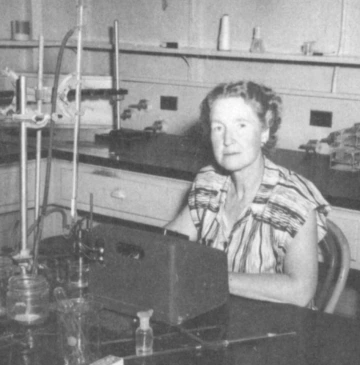
March 12, 2021
By Shane Burgess, Vice President for the Division of Agriculture, Life and Veterinary Sciences, and Cooperative Extension, University of Arizona
Margaret Cammack (Ph.D. Chemistry, Columbia University) arrived in Tucson in 1925 to be associate professor of home economics. In 1927, she left the Department of Home Economics to take a primary appointment with the Arizona Experiment Station and by 1935 she was back in a UA department as head of the Department of Human Nutrition.
Margaret published widely in several disciplines, including plant sciences, agronomy, agriculture production, food science, home economics, public health, pathology, environmental toxicology, epidemiology, chemistry and nutrition. She was a national figure in nutrition research. Contemporary documents cited her as “Arizona’s leading nutrition chemist”.
Margaret’s transformational medical science impact included identifying gender differences in utilizing dietary iron to form hemoglobin. Before her late 1930s findings, results from laboratory animal studies were confounded by the variance induced by using variably gender-mixed animal groups.
She is most famous though for linking fluorine levels in drinking water with serious tooth enamel and bone pathology, especially that high levels of fluorine in water cross the human placenta and cause lifelong enamel and bone pathology (“fluorosis”; Science, 18 Jan 1935: Vol. 81, Issue 2090, pp. 77). She also identified fluorine compounds in agricultural insecticides introduced in the 1930s as causing fluorosis in local human populations.
Concurrently biochemist Gerald J. Cox (Mellon Institute, Pittsburgh) reported in a series of papers that adding fluoride to drinking water increased resistance to tooth cavities. The U.S. Public Health Service then recommended a national water fluoridation campaign to prevent teeth cavities. Notably, Margaret also recognized fewer cavities in people with fluorosis, but she’d also identified that when cavities did appear in these people, they were virtually impossible to repair because the pathology meant teeth broke when dentists tried to anchor fillings.
Margaret warned that any national water fluoridation campaign should be done discriminatingly, i.e., not at all in places that already had adequate fluoride levels, and to decrease water fluoride levels in places where it was in excess. She advocated a data-informed approach. In 1945 Margaret also patented a process to decrease water fluoride below toxic levels.
Reminiscent of today, water fluoridation became very political. At March 1952 Congressional committee hearings, Margaret testified. The committee recommended a "go slow" and research to identify optimum fluoride levels for human food and water.
If you read her scientific papers or read about our enterprise’s history, you will see that Margaret was also an extremely dedicated mentor and perpetual collaborator. She was a team scientist. One of her collaborators was an agricultural chemist, Howard V. Smith. In 1927, long before their shared Science paper, Margaret and Howard married.
I’ve highlighted Dr. Margaret Cammack Smith, one of the enormous number of inspirational female scientists I could have chosen from, not only because of her scientific impact and that she walked in the same places we do today but because Margaret and Howard were part of a 1938-39 court case against ABOR seeking the right for married partners to be employed at the same university. Margaret is also among our pioneering graduates and faculty in home economics who have taken long, hard, and very public social justice actions and stands.
Both Dr. Smiths took a big risk—academic freedom and tenure were not norms until after the American Association of University Professors and the Association of American Colleges jointly published the "1940 Statement of Principles on Academic Freedom and Tenure". Just think how many faculty married to each other are working at the UA today… and what else has changed and is changing because of those living Margaret’s example.
Media contact:
Bethany Rutledge, Director of Administration and Communications, Office of the Vice President and Dean
520-621-7198, rutledge@cals.arizona.edu

